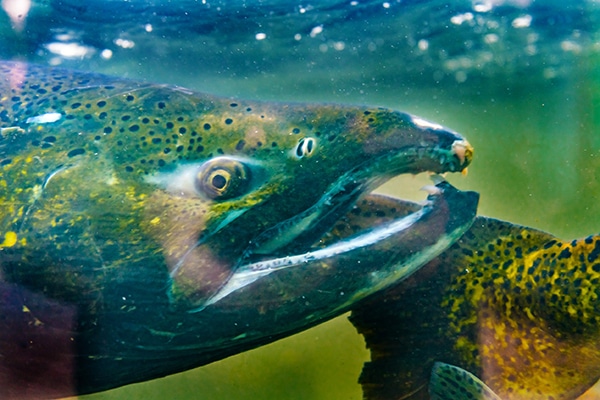On April 6, the Pacific Fishery Management Council (PFMC) provided their recommendations for the 2023 ocean salmon seasons to the U.S. Secretary of Commerce for final approval. State, tribal and federal fisheries managers throughout California, Oregon and Washington developed these recommendations over the past three months by working closely with recreational, commercial, and environmental groups, including ASA. Once approved, the final seasons will be available on PFMC’s website.
The final recommendations were mixed for this year. In 2023, west coast salmon anglers will see opportunities ranging from long seasons targeting abundant coho and pink salmon to complete fishery closures to protect Chinook salmon not meeting conservation objectives. Due to salmon migration occurring across a large portion of the West Coast, managers were challenged with developing opportunities that target abundant stocks, but limit impacts to stocks that are not meeting conservation objectives. Additional constraints salmon managers faced include addressing the needs of southern resident killer whales and previous commitments agreed to with Canada and native tribes and state policies.
Below is information on the various recommendations the PFMC provided the Secretary of Commerce for salmon fishing throughout California, Oregon and Washington.
California
California Department of Fish and Wildlife (CDFW) staff estimate that less than 170,000 fall Chinook salmon are expected to return to the Sacramento River this year, one of the lowest forecasts in 15 years and 200,000 fewer than returned in 2022. Biologists also anticipate that only 104,000 fall Chinook salmon will return to the Klamath River in 2023, the second-lowest estimate since 1997.
Due to such a low number of salmon expected to return to California in 2023, state and federal fisheries managers recommended a complete closure of recreational and commercial fishing. Many recreational anglers voiced their frustration about the closure at the March PFMC meeting in Seattle, stating that inaccurate preseason forecasts, the lack of in-season management, in-river policies that don’t prioritize the needs of fish and the recent drought all contributed towards the closure. Last year, biologists with CDFW estimated that only 61,000 adult fall Chinook returned to the Sacramento River. This is the lowest estimate on record and is likely to impact recreational opportunities for several years.
Although the full season closure is frustrating, the good recent news regarding California salmon is that precipitation has significantly increased this winter, which should improve in-river conditions for both juvenile and adult salmon.
Oregon
This year’s coho forecast, also known as Oregon Production Index (OPI), includes hatchery and natural origin fish returning to rivers from Leadbetter Point in Washington to the Mexican border. The OPI forecast is for 1.13 million coho, approximately 250,000 more than 2022. The fall Chinook forecast for the Oregon coast is anticipated to be similar to last year’s return.
Recreational anglers off the Oregon coast will see a mixed bag of opportunities in 2023. Fishing from Cape Falcon to the California border is proposed to open on June 17 with a quota of 110,000 hatchery coho. Except for a limited opportunity in September, Chinook retention will be prohibited in 2023 south of Cape Falcon to limit impacts to fish returning to California. Recreational fishing north of Cape Falcon to Leadbetter Point in Washington is proposed to open on June 24 with a 79,800 hatchery coho quota and an 11,490 Chinook quota. This year’s Chinook quota is approximately 33% more than the 2022 quota. specific information about recreational opportunities in Oregon can be found on the ODFW website.
Washington
Washington appears to be the salmon bright spot for 2023! The 2023 Puget Sound fall Chinook forecast of 290,000 (hatchery and natural origin combined) is approximately 10,000 more than last year’s forecast.
Biologists are also anticipating a return of 760,000 coho to Puget Sound, nearly 100,000 more than last year. The other good news is that staff are predicting a return of nearly 520,000 coho to north coastal rivers, which is roughly 80,000 more than last year. Lastly, biologists are forecasting a return of approximately 4 million pink salmon to Puget Sound rivers in 2023.
Recreational fishing will open north of Leadbetter Point to the Queets River on June 24 and from the Queets River to the U.S. Canada border on June 17. The hatchery coho quota is like last year’s, but the fall Chinook quota is approximately 50% higher in 2023. Puget Sound fisheries are proposed to be managed under a variety of opening dates and bag limits that were carefully developed to protect ESA listed stocks. The constraining stocks this year include fall Chinook returning to the Stillaguamish and Snohomish rivers. Specific details about these opportunities are available on the WDFW website.
California Disaster Declaration
Despite Washington’s strong season, this year’s sportfishing closure in California will significantly impact our industry. On April 6, Governor Gavin Newsom and Lieutenant Governor Eleni Kounalakis announced a request for a Federal Fishery Disaster Declaration to support the salmon fishing industry. According to the Golden State Salmon Association, the economic impacts associated with the closure of salmon fishing in California is estimated at $1.7 billion dollars.
Looking Ahead
As mentioned above, now that the PFMC gave their final approval to the 2023 recommendations, the next step is to get the U.S. Secretary of Commerce to give final approval, which seems likely. If you have any additional questions on the upcoming west coast salmon season or ASA’s role in the process, please do not hesitate to contact me via email.
Share This Article, Choose Your Platform:
Recent Posts



